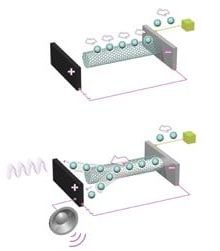NanoRadio

If you own a sleek iPod Nano, you’ve got nothing on Alex Zettl. The physicist at the University of California, Berkeley, and his colleagues have come up with a nanoscale radio, in which the key circuitry consists of a single carbon nanotube.
Any wireless device, from cell phones to environmental sensors, could benefit from nanoradios. Smaller electronic components, such as tuners, would reduce power consumption and extend battery life. Nanoradios could also steer wireless communications into entirely new realms, including tiny devices that navigate the bloodstream to release drugs on command.
Miniaturizing radios has been a goal ever since RCA began marketing its pocket-sized transistor radios in 1955. More recently, electronics manufacturers have made microscale radios, creating new products such as radio frequency identification (RFID) tags. About five years ago, Zettl’s group decided to try to make radios even smaller, working at the molecular scale as part of an effort to create cheap wireless environmental sensors.
Zettl’s team set out to miniaturize individual components of a radio receiver, such as the antenna and the tuner, which selects one frequency to convert into a stream of electrical pulses that get sent to a speaker. But integrating separate nanoscale components proved difficult. About a year ago, however, Zettl and his students had a eureka moment. “We realized that, by golly, one nanotube can do it all,” Zettl says. “Within a matter of days, we had a functioning radio.” The first two transmissions it received were “Layla” by Derek and the Dominos and “Good Vibrations” by the Beach Boys.
The Beach Boys song was an apt choice. Zettl’s nano receiver works by translating the electromagnetic oscillations of a radio wave into the mechanical vibrations of a nanotube, which are in turn converted into a stream of electrical pulses that reproduce the original radio signal. Zettl’s team anchored a nanotube to a metal electrode, which is wired to a battery. Just beyond the nanotube’s free end is a second metal electrode. When a voltage is applied between the electrodes, electrons flow from the battery through the first electrode and the nanotube and then jump from the nanotube’s tip across the tiny gap to the second electrode. The nanotube–now negatively charged–is able to “feel” the oscillations of a passing radio wave, which (like all electromagnetic waves) has both an electrical and a magnetic component.
Those oscillations successively attract and repel the tip of the tube, making the tube vibrate in sync with the radio wave. As the tube is vibrating, electrons continue to spray out of its tip. When the tip is farther from the second electrode, as when the tube bends to one side, fewer electrons make the jump across the gap. The fluctuating electrical signal that results reproduces the audio information encoded onto the radio wave, and it can be sent to a speaker.
The next step for Zettl and his colleagues is to make their nanoradios send out information in addition to receiving it. But Zettl says that won’t be hard, since a transmitter is essentially a receiver run in reverse.
Nano transmitters could open the door to other applications as well. For instance, Zettl suggests that nanoradios attached to tiny chemical sensors could be implanted in the blood vessels of patients with diabetes or other diseases. If the sensors detect an abnormal level of insulin or some other target compound, the transmitter could then relay the information to a detector, or perhaps even to an implanted drug reservoir that could release insulin or another therapeutic on cue. In fact, Zettl says that since his paper on the nanotube radio came out in the journal Nano Letters, he’s received several calls from researchers working on radio-based drug delivery vehicles. “It’s not just fantasy,” he says. “It’s active research going on right now.”
Keep Reading
Most Popular
Large language models can do jaw-dropping things. But nobody knows exactly why.
And that's a problem. Figuring it out is one of the biggest scientific puzzles of our time and a crucial step towards controlling more powerful future models.
The problem with plug-in hybrids? Their drivers.
Plug-in hybrids are often sold as a transition to EVs, but new data from Europe shows we’re still underestimating the emissions they produce.
Google DeepMind’s new generative model makes Super Mario–like games from scratch
Genie learns how to control games by watching hours and hours of video. It could help train next-gen robots too.
How scientists traced a mysterious covid case back to six toilets
When wastewater surveillance turns into a hunt for a single infected individual, the ethics get tricky.
Stay connected
Get the latest updates from
MIT Technology Review
Discover special offers, top stories, upcoming events, and more.